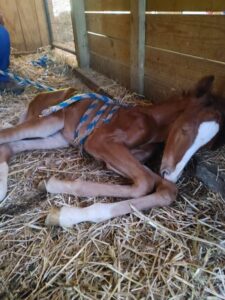
So many of you reached out with questions after we shared Capri’s birth story earlier this week — and we wanted to take a moment to explain what happened.
Capri was what’s known as a “Dummy Foal,” which means she wasn’t meeting the critical milestones we expect shortly after birth: standing within an hour, nursing within two. In the wild, foals are prey animals — they need to be up and mobile fast, and they absolutely must receive colostrum (that first milk) to kickstart their immune system.
In Capri’s case, she was alert, moving normally, and clearly wanted to nurse. She had the instinct, but no matter how many times she tried, she just couldn’t figure out how to latch. It was stressful to watch, and increasingly urgent.
Because we have a proactive relationship with our vets, they responded immediately. After assessing her, they determined that Capri was likely experiencing Neonatal Maladjustment Syndrome aka Dummy Foal — a rare condition sometimes caused by a disruption in the birthing process, especially when delivery is very fast. Essentially, the foal’s brain doesn’t get the signal that it’s time to “wake up” and fully join the world.
Our vet performed the Madigan Squeeze, a gentle but remarkable procedure that simulates the pressure of the birth canal and helps reset the foal’s brain. The rope around her chest in this photo is the source of the pressure. For about 20 minutes, Capri was placed in a sleep-like, catatonic state. We were beyond nervous — trying our best to stay calm for her mother, Topanga, who never left her side.
What happened next was nothing short of amazing. Capri slowly began to stir. And then, like a light had turned on, she found her feet, found her mom… and finally figured out how to nurse.
She’s been thriving ever since.
We share this to raise awareness — and to underscore how *vital* it is to have a vet you trust, who knows your animals, and who can respond without hesitation. We are so grateful.